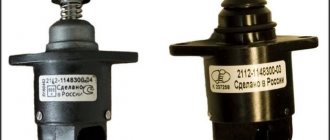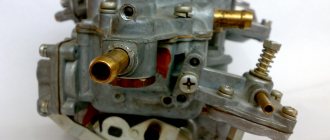Replacing the crankshaft sensor Lada 21074 (VAZ 21074)
The VAZ 2107 crankshaft position sensor is necessary to determine the position of the crankshaft connecting rods and synchronize the fuel injection nozzles. The sensor is electromagnetic and is used in electronic injection systems. After the sensor is removed from the car, it must be checked and only after that, making sure that it is not working, replace it with a new one. To check, you will need a multimeter with voltmeter mode, and a standard set of tools.
To remove the crankshaft position sensor:
- We disconnect the block with power wires from the sensor, having first released the plastic clamp of the block.
- Unscrew the screw securing it using a Phillips screwdriver.
- We remove the sensor from the mounting bracket in the camshaft drive cover.
In this simple way, after removing the crankshaft sensor from the car, it needs to be checked. To check, take a regular voltmeter. The sequence of actions is as follows:
- We connect the terminals of the voltmeter to the sensor terminals.
- Next, with an intensive movement, we draw the screwdriver blade near the end of the sensor and at the moment when the screwdriver is against the sensitive element, the voltmeter will record a small voltage surge, which will indicate the serviceability of the sensor. If the voltmeter does not react in any way to the movements of the screwdriver, then the sensor needs to be replaced.
At this point, the repair work on removing and checking the crankshaft position sensor of the VAZ 2107 is completed. Reassemble in the reverse order of removal.
Source
avtozam.ru
Crankshaft position sensor design
The design of the DPKV is simple and consists of a small number of elements. In particular, its main element is a magnetized steel core on which a thin copper wire is wound. On top they are covered by a plastic (plastic) case. Naturally, in a copper winding, all the wires are insulated from each other (this can be implemented in different ways, for example, through compound resin or conventional insulation made of PVC or other material).
The operating principle of the device is as follows. In the immediate vicinity of the sensor, a “monitoring” disk with teeth around the perimeter rotates. Two of them are missing, creating a kind of emptiness. The main task of the sensor is to record the passage of this section and send appropriate signals to the ECU. If it does this late or with a weak signal, the electronic unit will provide incorrect information to the fuel system, and a mixture of suboptimal composition will be formed.
Methods for checking DPKV
There are three main ways in which you can check the performance of the crankshaft position sensor. This can be done without complex instruments (accuracy in this case is not guaranteed), but the device must be dismantled before testing. At the same time, marking its position with marks. This is necessary so that during subsequent installation you will not have problems starting the engine.
So, the first test method is to measure the resistance of the inductor. The method is the simplest, but it does not give complete confidence in the accuracy of the result. To perform this procedure, you need a standard electronic multimeter turned on in insulation resistance measurement mode.
The test is carried out in pairs at the wire terminals. If everything is in order with the insulation, then the corresponding value will be in the range from 500 to 700 Ohms. If this value is lower, then there is a high probability of an interturn short circuit. As a result, the sensor will produce incorrect values.
The second method is to check the inductance of the coil. As for instruments, in this case you can directly use a digital multimeter that has an inductance measurement mode. Otherwise, additional equipment with the corresponding function must be used. The inductance value is usually between 200 and 400 H.
Malfunctions of the crankshaft sensor - design and principle of operation
Signs of a malfunctioning crankshaft sensor warn the driver that urgent repairs are necessary, which has a direct impact on engine performance. This unit pinpoints the moment when hot water needs to be supplied to the internal combustion engine cylinder. If the sensor malfunction is not corrected, the engine will stop working.
What is a crankshaft sensor
The crankshaft speed sensor is a device that is installed on vehicles equipped with an electronic engine management system. It allows the engine to control the location of the crankshaft. This kind of control is required in order to ensure stable operation of the fuel injection system.
Symptoms of a faulty crankshaft sensor can cause the engine to stop, so it is necessary to notice the main signs of a faulty DPKV in time. A malfunction in the operation of the DPKV provokes problems in the power system, which begins to block the timely supply of fuel. This results in the ignition system not igniting the fuel-air mixture.
Crankshaft sensor location
The location of the DPKV is a bracket that is located in the central part of the pulley on the generator drive. It is installed next to the drive toothed pulley structure with a gap of 1-1.5 mm.
To replace the sensor or adjust it, you need to connect a wire 50-70 cm long to it. To set or correct the position, you need to adjust the washer, which is fixed above the DPKV mounting socket.
Before replacing this device, it is recommended to diagnose it. Many car enthusiasts are concerned about the question of what else needs to be done before removing it - measurements should be taken based on the ratio of the mounting bolts to the body and the position of the DPKV.
How does the crankshaft sensor work?
Many people are interested in the question of why a crankshaft sensor is needed. This device directly affects the performance of the car engine.
A violation provokes malfunctions of the internal combustion engine or engine shutdown, affecting engine operation.
The functions of the DPKV include:
- synchronization of fuel injectors;
- synchronization of the ignition system.
The principle of operation of the DPKV is that it sends a signal to the ECU. This message indicates the position of the crankshaft. Such a signal contains information about the frequency and direction of rotation of the crankshaft.
Crankshaft sensor device
The system of this crankshaft element includes:
- Sensor winding
- Frame
- Sealant
- Drive unit
- Mounting bracket
- Magnetic core
- Sync disk
Repair involves the need to ring the DPKV using an ohmmeter. For these purposes, it is necessary to measure the resistance on the winding of the unit.
Signs of a faulty crankshaft sensor
Signs of a malfunctioning crankshaft position sensor:
- disruption of the smooth combustion process of the fuel-air mixture (detonation) in the engine under dynamic load;
- at idle speed becomes unstable;
- low vehicle engine power level;
- reduction in the level of vehicle dynamics;
- the engine does not respond to ignition, i.e. it won't start;
- the car jerks as it moves;
- uncontrolled increase or decrease in speed.
Malfunctions in the functioning of the DPKV can be periodic and do not always make themselves felt. In this case, it is necessary to use a computer engine diagnostic service, which can accurately determine the cause of the problem.
Reasons for failure:
- Short circuit between turns in the DPKV winding. As a result, the impulses are lost to the ECU. Here it is necessary to replace the device.
- Breakage of the teeth of the drive ring.
- Non-working contacts that are located in the winding and wire supply system. In these circumstances, it is not necessary to change the DPKV, but to clean the connection and winding.
- The reason for the failure of the DPKV can also be the presence of mechanical damage that was received during the period of work under the hood.
- Another circumstance that can lead to crankshaft failure may be the entry of foreign objects into the area between the DPKV and the toothed pulley.
These errors and malfunctions in the vehicle may be caused by other breakdowns. The crankshaft position sensor, signs of malfunction of which can be caused by various circumstances, requires careful inspection.
How to check the crankshaft sensor yourself
There are 3 ways to check for a faulty crankshaft sensor:
- measurement using an ohmmeter;
- checking the inductance value;
- using an oscilloscope.
Checking the crankshaft position sensor using an ohmmeter:
- For this test you need to purchase a multimeter.
- It must be placed in the resistance measurement position.
- Then measure the resistance level of the inductor: use the probes of the device to touch the coil terminals.
- Acceptable value is 500-700 Ohm.
- If the measurement results are within the specified range of values, then the crankshaft is normal.
Checking the crankshaft sensor using an inductance measurement:
- You need to get a megohmmeter and a network-type transformer. You also need to purchase an inductance meter and a voltmeter.
- Using a multimeter, measure the inductance.
- Normal values are 200-400 mH.
- Using a megohmmeter, measure the insulation resistance between the coil wires.
- The obtained data should not be lower than 0.5 Mohm.
- The coil is demagnetized using a network transformer.
- A deviation from the norm indicates that the crankshaft sensor needs to be replaced.
The oscilloscope gives a complete picture of the state of the DPKV. To diagnose, you must perform the following steps:
- Connect the probes to the wires that lead to the coil.
- Open the software for working with the oscilloscope.
- Pass a metal object in front of the DPKV.
- All data will be reflected on the screen.
If the DPKV detects the movement of a metal object, then the sensor is in good condition. This diagnostic method is recommended to be carried out with the engine running, so the results will be more accurate. To do this, you will need to connect the probes in parallel to the sensor terminals.
djago.ru











